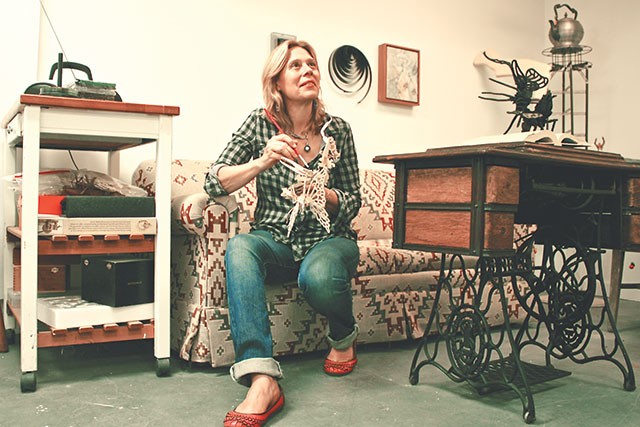Here hang the bones of the unknown. Insect wings dangle down and twirl slightly in the breeze of an opened backdoor. Ribcage constructions rest on the tops of antique tables. This is not an artist’s studio, this is the laboratory of some insane alchemist. Natural forms are dissected and remade unnatural. Grasshopper segments are fused to human legs, a spectrum of thread stands ready to be sewn, a crisp, dead frog rests face down in a jar, dried cacti are tacked to a wall, the carapaces of beetles and black widows are pinned down, and books full of collected curiosities are scattered about, revealing the work of a keen and inquisitive observer.
On some suburban corner, lost inside the 1604 loop, is a nondescript building with many past lives. It was once a fire station, once a search center for a missing child, once a DEA headquarters. The place runs rampant with invisible memories. Now it is the studio of artist Jayne Lawrence. Trained at the Colorado Institute of Art, San Antonio Art Institute, and the University of Texas at San Antonio, she is the co-founder of the renowned alternative art gallery, cactus bra Space, and a longtime fixture in the San Antonio art world. As we tour her studio, Lawrence is in constant motion, always fluid. The camera struggles to capture her wild gestures and laughter.
We continue on through corridors. Her art hides in every nook of the studio: human arms and legs jut out of the body of a giant, bicep-boasting banana, flowers and vines sprout from the top of a jester’s torso, and lemons pucker their lips. This newer work, for her upcoming Sala Diaz show, is more sinister, the whimsy stripped off in favor of the skeletal architecture beneath. Skin is peeled away, insects are crushed and scattered about, and roots or tendons, sometimes both, are spread across stark, white paper. I ask what fascinates her about architecture, insects, and human limbs. “Architecture is a snapshot of who we are. It is time, location, dwelling and culture,” she says. “Insects represent ‘the other,’ that which is like us but not us, alien, foreign, or different. They are repulsive and attractive. They are beautiful, intricate, and complex.”
“Why use human limbs instead of faces?” I inquire.
“A human face would create a one-on-one relationship,” she says. “We are accustomed to the idea of self, oneness, the individual. It is not the same for the insect. One can represent the group.”
A few days pass and a skeleton is constructed, bound for Sala Diaz. It sits in the center of the room, squatting on a stack of books, like some mythological horror with a frog body, butterfly wings, mandibles, and human legs. It is coming together, but in no truly identifiable way. Partially painted the yellow of paper left too long in the sun and fading into a subtle, bruise-like purple, it is striking in its strangeness. There is no one place to focus. The eyes must trace around the work to take in the entirety.
Made of almost 50 pieces, the blue foam is cut, fitted, sanded, coated with polymer, re-sanded, primed, and finally painted. And today Lawrence and her studio mate, Katherine Pickens, must deal with a small disaster: one of the pieces has been glued upside down, throwing the entire structure into disarray. It needs to be cut out, and possibly repaired or replaced. A smaller mockup rests on an antique sewing table. They look to it as a sort of map, but they are building a house of cards with much larger, heavier cards now. Things need to change. The structural integrity is questionable. “The butterfly here, the mandible here, the frog here…” Lawrence says, pointing, as she and Pickens step in slow circles, careful to not trip over the delicately long insect legs. They build, adjust, move, flip, tilt, and replace, until eventually the pieces fit into their proper place, and they find the correct equilibrium.
Lawrence slowly exhales. There are many more battles to come, but for now, the fight is over. I ask her what she wants the viewer to take away after experiencing her art. “I’d like for them to see something they couldn’t have imagined and leave the gallery looking,” she replies.
Later, at home, I’m scratching insect bites when the exterminator arrives. He moves about the house, spraying his silent death into every crack and corner. Outside, he soaks the anthills and hornet nests. I’ve been dreaming about black widows and the architecture of insects.
Jayne Lawrence: Infestation
Free
Opening reception 7-11pm Fri, May 10
Sala Diaz
517 Stieren
(210) 852-4492
saladiazart.org
On view by appointment through June 16
















